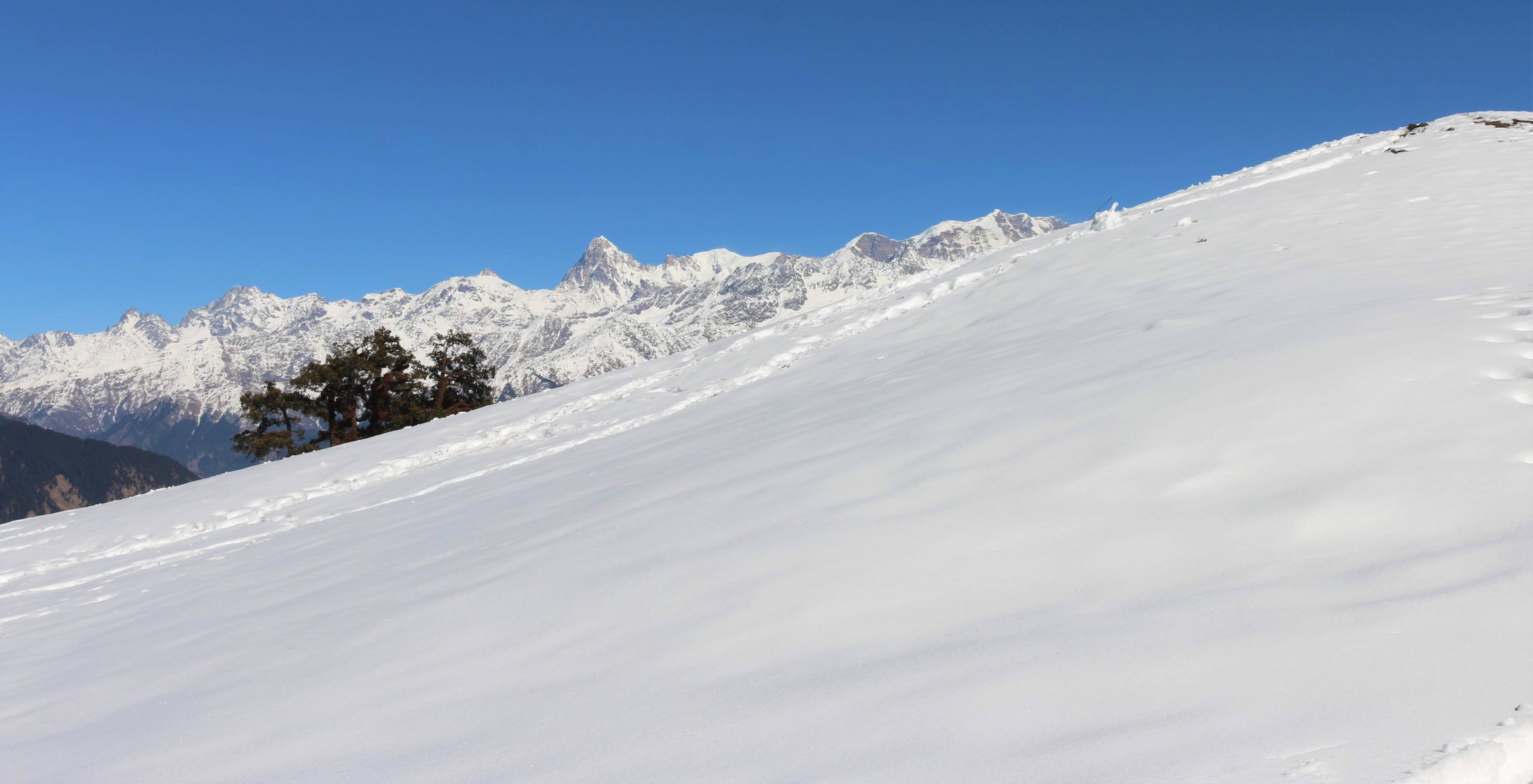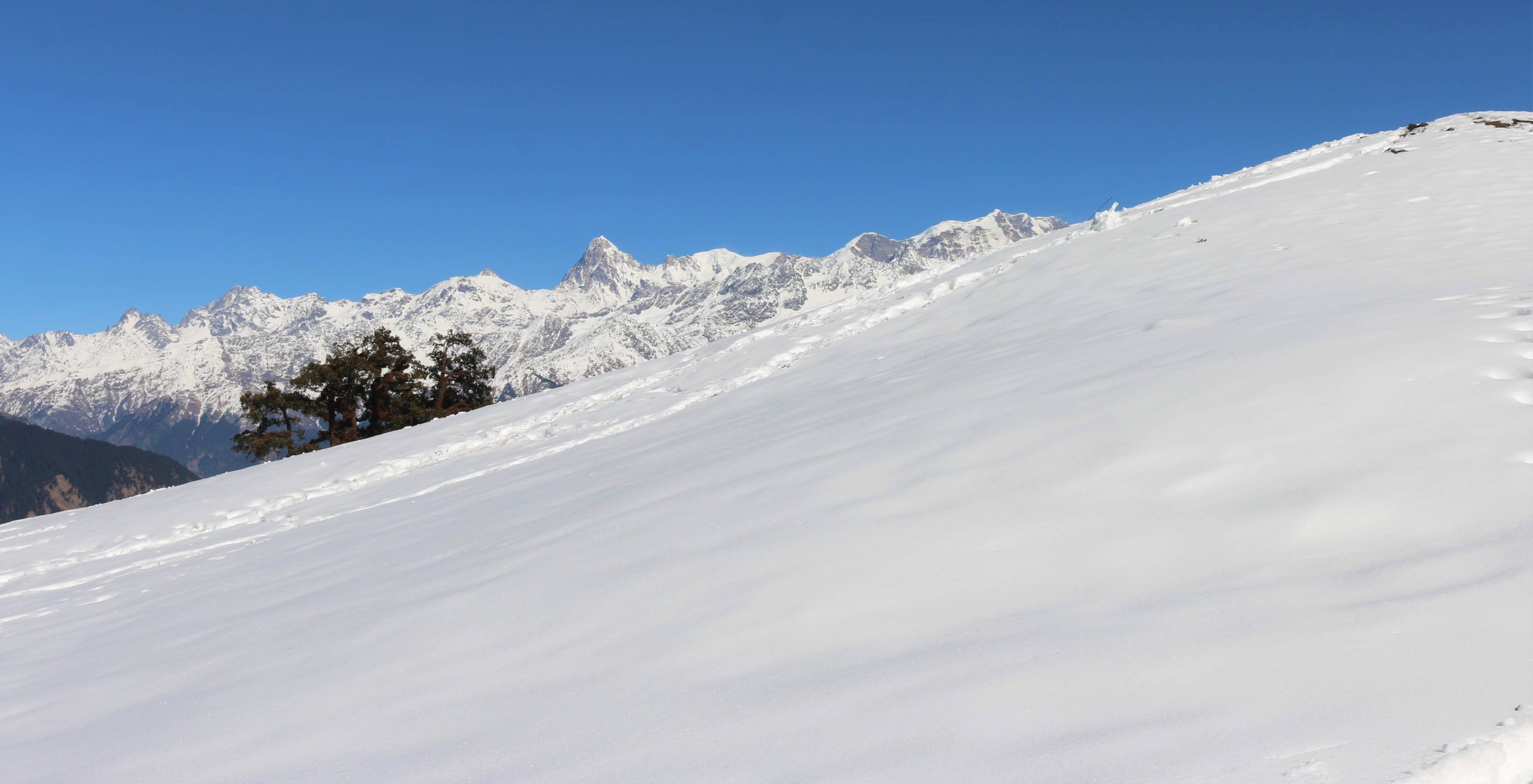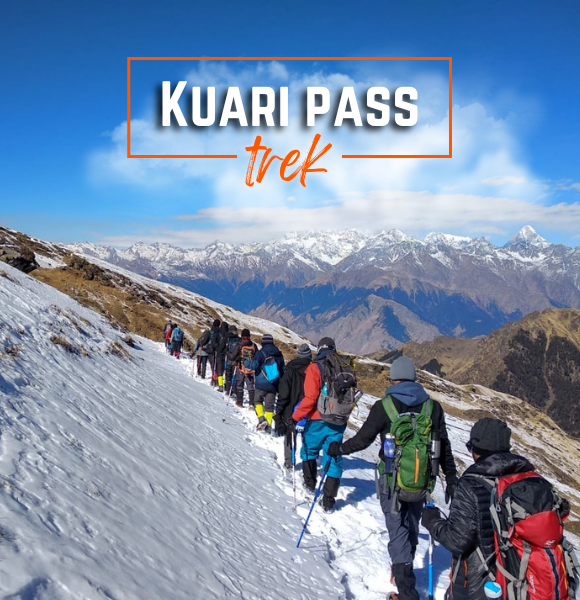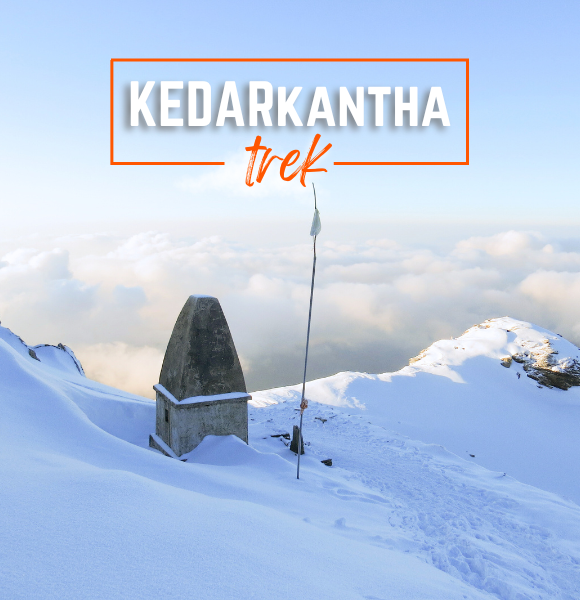Trek Grade
Easy - Moderate
Highest Altitude
12,090 ft
Base Camp
Raitha
Best Time
Round the year except Monsoon
Dayara Bugyal Trek
Starting from INR
Package Variant
No package variant available.
Dayara Bugyal Trek
At Dayara Bugyal Trek, we deeply admire the meticulously manicured meadows, which offer a picturesque setting that’s hard to beat. The attention to detail in landscaping is evident, with no single rock or tree out of place, creating a breathtaking backdrop for the majestic Gangotri mountain range. The rewards of this trek are disproportionate to the effort put in, making it a popular choice for beginners as well. The location of Dayara Bugyal, situated at an elevation of over 10,000 feet, is a significant factor in its beauty. From this vantage point, the Greater Himalayan range stretches out in all its glory, with the towering summits of the Gangotri range, including Bandarpunch, Kala Nag, Srikanth, Jaonli, and Draupadi Ka Danda, seemingly within reach. Trekkers often spend hours gazing at the sunset over these mountains, taking in the awe-inspiring sight.
During the summer, the meadow becomes renowned for its vibrant array of alpine flowers, showcasing a splendid mix of hues. The oak and rhododendron forests encircling the meadow add to the picturesque scene, providing a stunning contrast against the majestic snow-capped mountains. This trekking route also serves as a habitat for various bird species, including the Himalayan monal, which holds the esteemed title of Uttarakhand’s state bird.
The landscape is dominated by dense forests of maple, oak, and misty valleys, creating a picturesque setting that changes with the seasons. During heavy snowfall, ski enthusiasts flock to the highland meadows while trekkers explore the lush grasslands, serene alpine lakes, and babbling streams that offer a sensory retreat. The trek also provides a glimpse into the unique culture of a Himalayan village, and the vibrant Rhododendron flowers that line the trails add to the overall beauty of the experience.
Want To Trek Like Pro?
Check out the following videos if you want to trek like a pro trekker and improve your skills. These videos contain helpful tips, tricks, and techniques to help you trek like a pro. Whether you’re a beginner or an experienced trekker, these videos can provide valuable insights to enhance your trekking experience. So, watch the videos below by The Dreamtrips experts to take your trekking skills to the next level.
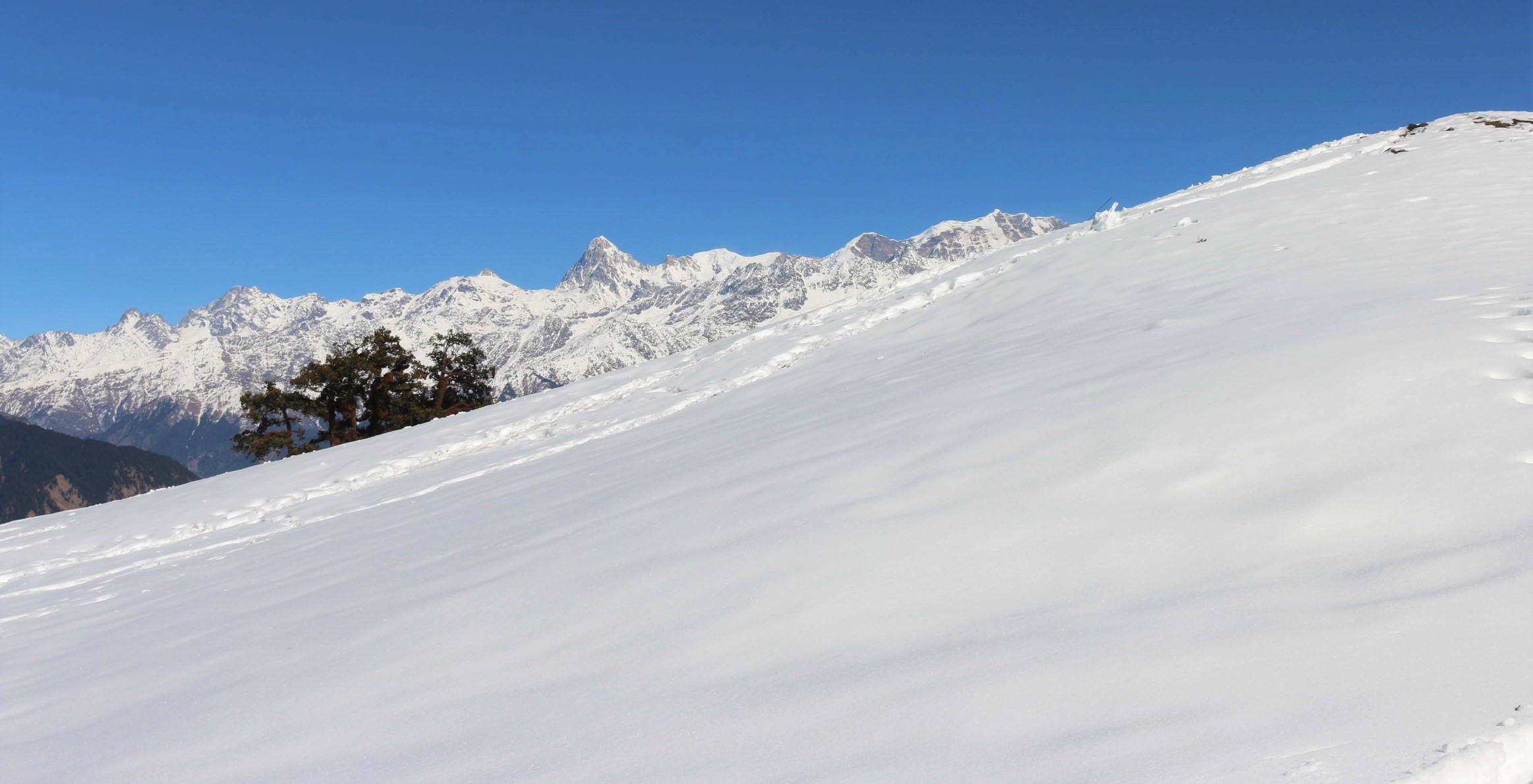
Know Everything About Acute Mountain Sickness
Acute Mountain Sickness is a medical condition that can occur when individuals travel to high altitudes, typically above 8,000 feet. It is caused by the decrease in air pressure and oxygen levels in the air as altitude increases. Symptoms of Acute Mountain Sickness may include headache, nausea, vomiting, dizziness, and difficulty sleeping. To avoid Acute Mountain Sickness, it is important to gradually adjust to high altitudes and seek medical attention if symptoms worsen. To learn more about this condition, check out the videos by The Dreamtrips.
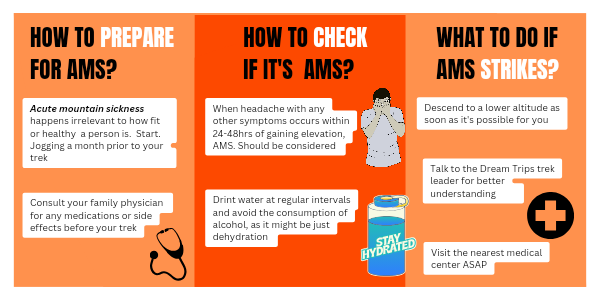
Day Wise Detailed Itinerary
- Altitude: Raithal Village 2176 meter / 7142 feet
- Drive time: 8-9 hours.
- Driving Route: Dehradun – Suwakholi – Moryana Top – Uttarkashi – Bhatwari – Raithal
- Pick-up Location: Prince chowk, Dehradun is 06:30 AM
- View of Gangotri range starting from Moryana Top.
- Stay in a Guesthouse
On the first day of the Dayara trek, participants will go to our homestay in Raithal, Uttarkashi. Those who have opted for a drive from Dehradun to Raithal with Bikat should arrive at the meeting point by 6.30 AM. During the journey to the basecamp, we will acclimate to the mountain climate, get to know our fellow trekkers, and take in the breathtaking scenery, including yellow mustard fields, changing hilltop hues, the tranquil Bhagirathi river, and the stunning Tehri Dam Falls.
By taking the path through Dhanaulti, we can reach Chinyalisour. As we travel through these charming towns and villages in Uttarakhand, we will glimpse Raithal after passing through the lively town of Uttarkashi, following a quick route towards Maneri.
Once we had completed the lengthy journey and had some time to relax, we proceeded to provide an overview of our itinerary, impart knowledge on important guidelines and protocols, and educate participants on the importance of environmental conservation. As an organization dedicated to learning, we also offer a comprehensive briefing on essential trekking skills, including a demonstration on properly packing backpacks and sleeping bags. Additionally, we secure the necessary forest permits, complete any required paperwork, and obtain clearances on the first day to ensure a seamless and trouble-free trek for everyone involved.
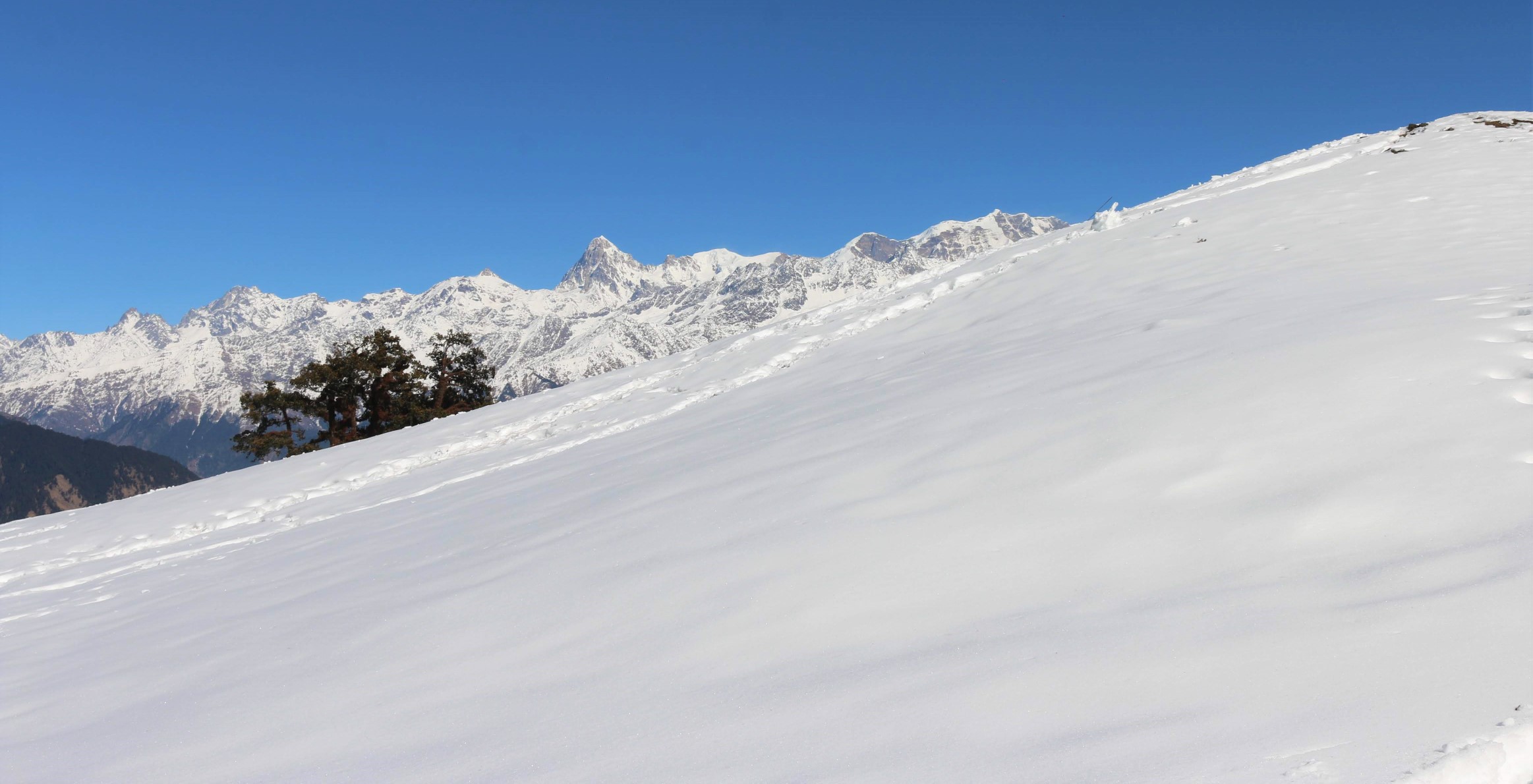
- Altitude: Gui 2,900m/9,500 ft
- Trek Duration: 4-5 hours
- Trek Distance: 4.3 kms
- Trail Type: Easy trail. Gradual easy ascent.
- Meals: Break fast at Raithal & Hot lunch on the campsite
- Stay: In tents on twin sharing
- A well-marked trail leads to the campsite
- Carry 2 litres water bottles if you don’t have access to water sources
After enjoying a satisfying morning meal, we begin our journey from Raithal village towards our camp near Gui Lake. At the start, the path meanders through a narrow passage lined with stepped farms and fields of ripe rice, accompanied by a nearby stream.
After an hour, we venture into a dense forest filled with wood and oak trees, known locally as Mohru and Pangar. This continues until we reach a spacious area with shepherd shielings. Our camping spot is not too far from here. The trees create a thick canopy above us, giving us a feeling of being in the wilderness, far from the busy city life. From this picturesque location, we can catch a breathtaking view of Mt. Srikanth, Mt. Bandarpoonch, and DraupadikaDaanda peaks. On a clear and sunny day, we can even see the entire panorama of the Garhwal Himalayas, stretching from Gangotri to Mt. Jaonli, from these expansive grounds. Today, we will gain an elevation of approximately 848 meters.
After a brief break for snacks and rest, we continued our journey towards Gui Campsite, located approximately four hours away from Raithal. We arrived at the campsite by early noon and set up our tents with the help of a demonstration from the trek leaders.
After reaching our campsite, we enjoy a satisfying lunch, then prepare to explore the breathtaking Gui Lake, whose waters are frozen solid even during the day due to the cold winter temperatures near the lake. As we return to our campsite, the sky is painted with hues of orange and pink, creating a picturesque sunset that shouldn’t be missed. Afterwards, we delight in warm appetizers before having an early supper for the remaining part of the evening.
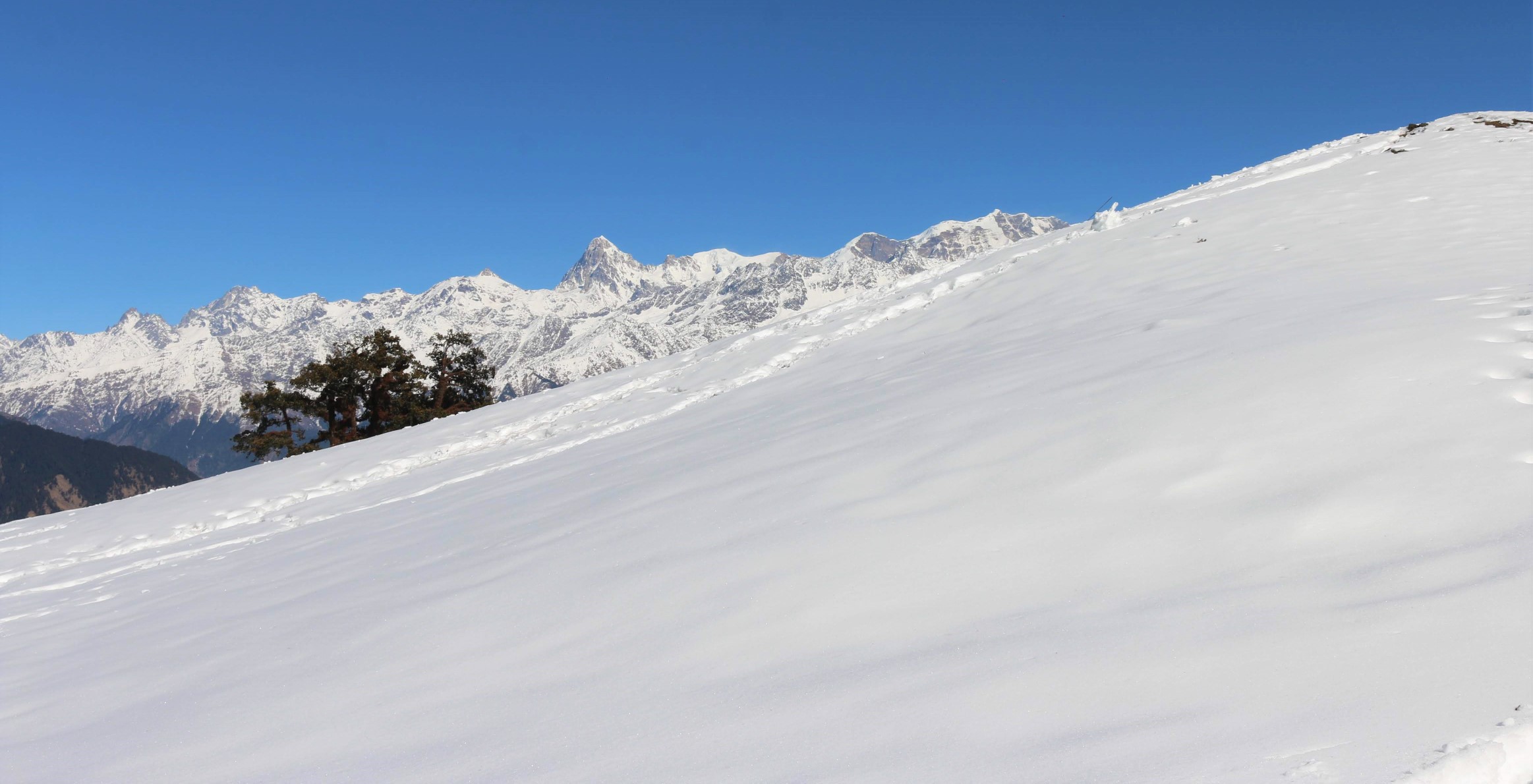
- Altitude: Dayara Top 3,700m/12,100ft
- Trek Duration: Approx 8 hours.
- Trek Distance: 5.3 kms one way
- Trek Grade: Moderate
- Meals: Breakfast, Pack Lunch & Dinner
- Stay: In tents on twin sharing
- Keep enough water with you, there is only one source of water near the top
After breakfast today, you will trek from Gui to Dayara Bugyal and Bakaria top Summit. With a packed lunch and be prepared for a day full of amazing views, including Bandarpunch (6,300 Meters) and Black Peak (6,387 Meters). The trail will take you up from Gui towards Dayara, where you will see the mountains on the other side, previously hidden from sight. The early morning sight of Dayara Bugyal is breathtaking, with vast meadows stretching in all directions and the sun’s rays illuminating them in various ways. Reaching this beautiful destination is worth the effort.
The breathtaking vistas of Bakaria Top’s surrounding peaks, including Draupadi Ka Danda, Shrikhand Mahadev, Mt Jaonli, and the Gangotri mountain range, are the primary draw of this picturesque location. As you ascend to the Summit, take in the stunning panoramic views of the towering Himalayan peaks. After reaching the Bakaria Top summit (12,645 feet) around 1:30 pm, take a moment to relax and enjoy a delicious veg biryani for lunch.
During the beginning of the season (May-June), numerous meadows are filled with an abundance of yellow, violet, and white flowers. Occasionally, the quantity is so vast that you have to go around them purposefully. The undulating landscape is covered in countless miles of soft, powdery snow in the wintertime.
Prepare yourself to journey down into the unspoiled fields. Follow the same path back and make your way back to the campsite.

- Trek Duration: 3-4 hours
- Trek Distance: 4.3 kms
- Trail Type: Easy Trail
- Meals: Breakfast at Gui and Hot lunch at Raithal
Trek from Gui to Raithal, then drive to Dehradun, covering a distance of 235 kilometres. After breakfast, descend back to Raithal village through a 4.5-kilometer trail. On the way back to Dehradun, passing through Uttarkashi, there will be lunch. Expect to arrive in Dehradun between 7:30 PM and 8:00 PM. Plan your further travel accordingly.
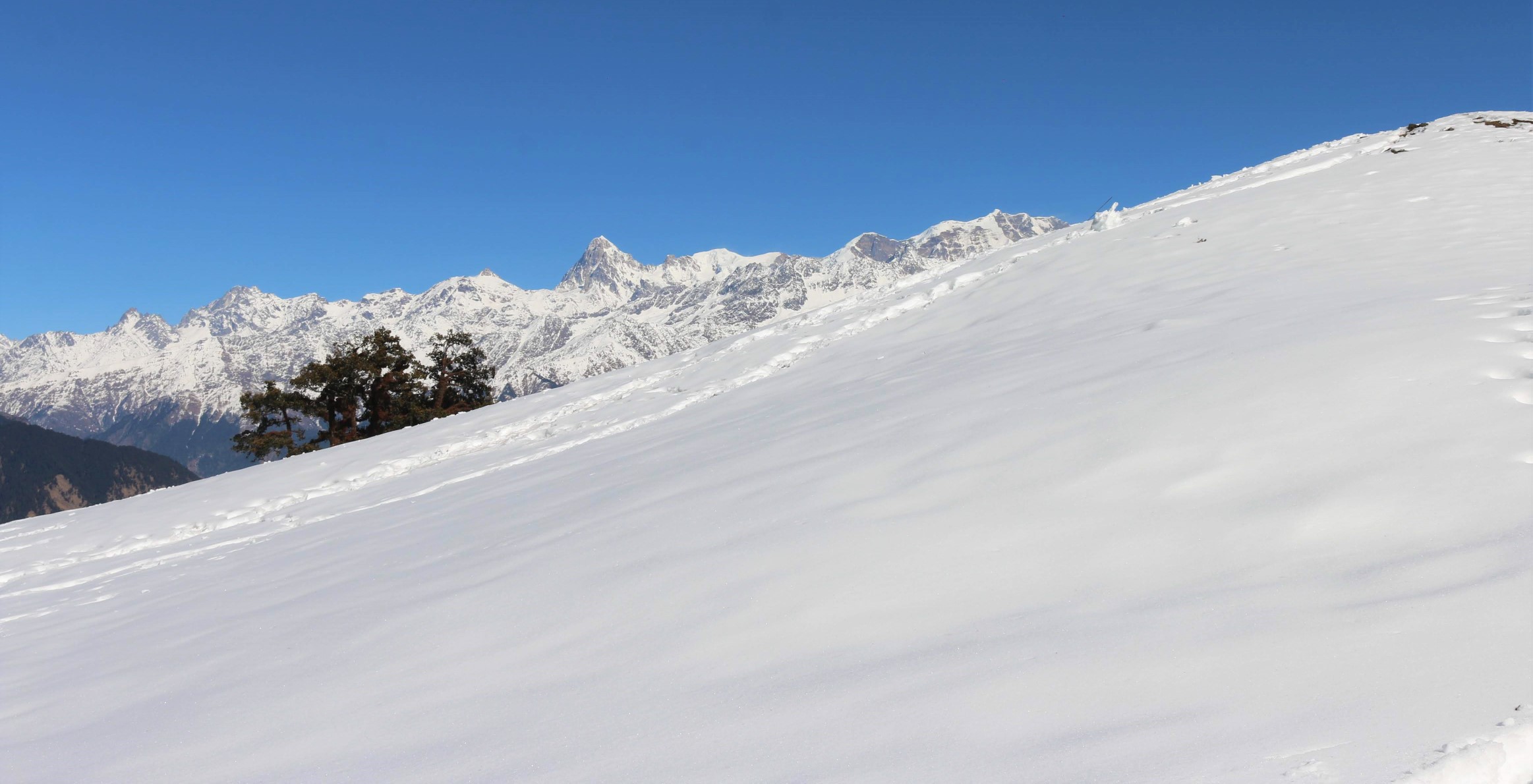
Dayara Bugyal Trek Route Map
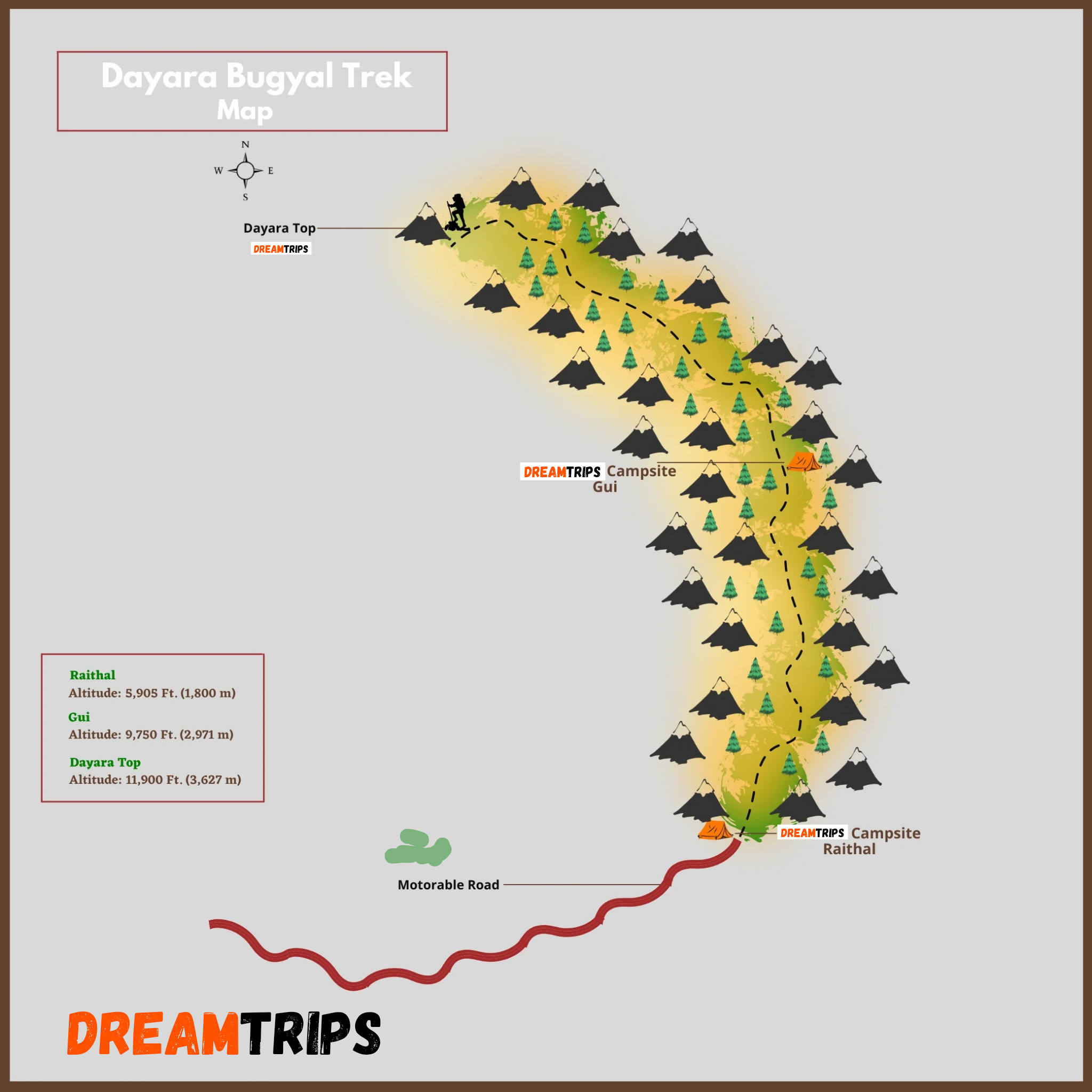
Dayara Bugyal Trek Altitude Chart
Inclusions
- Stay: 2 Nights in tented accommodation at respective campsites of The Dreamtrips on a sharing basis and 1 night in a guest house.
- Meals: The Dreamtrips provides freshly cooked meals during the trek, starting with Dinner on Day 01 to breakfast, lunch on day 4 (Meals are simple, nutritious, and vegetarian and non-repeated meals)
- Transport (Optional): Dehradun to Raithal and return on sharing jeeps
- Trek Insurance (Mandatory): The Dreamtrips recommends that all trekkers consider getting trek insurance. This is optional, but highly recommended. Trek insurance covers unexpected events that may occur during your trek. The cost of the insurance starts from INR 210.
- Trek Equipment: Sleeping bag, Sleeping tents, Kitchen tent, Dining tent, Toilet Tent.
- Amenities: All utensils, sleeping mattresses (Black foam mats), Crampons, and Gaiters for snow.
- Health & Safety: First Aid Box, Oxygen Cylinders, Stretchers, Oxi meters, BP Machines, health.
- Permits: Forest Permits and Camping Permission Fee
- Trek Crew: High Altitude Chef, Helpers, Trek Leader & Guides, and other support teams.
- Potters & Mules: Potters and Mules are to carry all trekking equipment, ration, and vegetables.
Exclusions
- GST 5% (it is Mandatory)
- Any Meals/accommodation beside the itinerary or not mentioned in the program.
- Any Bus / Airfare to/from trek start/end point
- Personal Medical expenses do carry your medication.
- Any personal services such as Laundry, phone calls, liquors, mineral water, etc.
- Any still / video camera fee
- Any Entrance fee Monuments, Monasteries, Museums, Temples – Pay directly on the spot.
- Mules or porter charges to carry private baggage (Offload Charges for bag 365 per day, per bag if paid online (at base camp 2,550). Note: Bag weight should not be more than 10 kg.
- Any emergency evacuation charges
- Any services that are not mentioned in the cost inclusion section.
What should you pack?

Head Gears
Heading out for a trek? Don’t forget to carry headgear to protect your beautiful face and head from the sun, wind, and dust! It’s an essential accessory that keeps you safe and comfortable throughout your adventurous journey. So, make sure you pack it before you step out into nature!
- Head Lamps – When trekking at night, headlamps are essential to illuminate your path while keeping your hands free. Headlamps come in different sizes and lumens, so it is essential to choose one that suits your needs.
- Hats or Cap – Caps or hats are also necessary when trekking in different weather conditions. Caps protect your head from the wind and freezing temperatures at night, while hats provide shade and protection from the sun during the day. It’s essential to ensure that your hat has a strap to prevent it from being blown away by the wind.
- Sunglasses – Sunglasses are also essential for trekking. Your sunglasses should protect your eyes from harmful UV rays and fit your face perfectly to avoid falling off while climbing, jumping, or crossing obstacles. The glass of your sunglasses should also be designed for different weather conditions to provide optimal visibility.
- Buff / Balaclava – Lastly, a buff or balaclava is a must-have to protect your mouth or neck from extreme temperatures and keep them warm. Buffs and balaclavas come in different materials, thicknesses, and designs, so it’s important to choose one that suits your needs and preferences. Depending on the weather conditions and your activities, you can wear them as neck warmers, face masks, or headbands.
With these essential items, you can enjoy trekking safely and comfortably, no matter the weather or time of day.
Clothes
Layering is important for different seasons when trekking. When planning a high-altitude trek, it is important to prepare for the cold weather. Wearing layers is the best approach as it provides both protection and flexibility when the weather changes frequently in the mountains. Layering helps to trap heat and keep your body warm, while at the same time allowing you to easily adjust your clothing as the temperature fluctuates. By wearing layers, you can enjoy your trek comfortably and stay safe in the unpredictable mountain weather
- For spring, summer, and monsoon treks, consider wearing three layers: a woollen sweater, a fleece, and a padded jacket.
- For autumn treks, add one more fleece layer to make it four layers.
- For winter treks, you may need five layers with thermals, a woollen sweater, two fleeces, and a padded jacket.
- T-shirt/sleeve shirt– Bring three T-shirts and two quick-dry trek pants, wearing one and carrying the others. Long sleeve shirts help to protect from sun UV rays. We recommend synthetic T-shirts as they get dry quickly when they get wet.
- Hiking / Trekking Jacket– down jackets (-5 to-10 C) or two-three-layer jackets.
- Thermals– at least two pairs of thermals help keep the body warm during cold weather.
- Undergarments– you can carry them according to your habitual and hygiene requirements.
- Gloves– 1 pair of gloves will keep your hand warm and nice.
- Trek Pants– Bring 2 to 3 comfortable trekking pants. Trekking pants play a significant role, as they are designed for comfort and mobility, making trekking easier. It should be Synthetic so that it gets dry quickly when wet.
- Rain Wear– you can carry a raincoat or Poncho. During long rains and snowfalls, the waterproof jackets start leaking. Still, the Poncho and raincoats keep you dry, so choose accordingly.
Tip: If you choose a raincoat on your trek, carry a small waterproof cover so things inside your backpack can’t get wet. If you carry a Poncho, you don’t need to worry. It protects both you and your backpack.
Foot Gears
- Trekking shoes which are waterproof and have ankle support. Walking / Hiking sandals which can be used off the trek, i.e., in the morning and evening hours when you reach the campsite, basically to get your feet rest from heavy boots, sometimes used for crossing streams and rivers, it’s more comfortable and safer than crossing barefoot or wetting your shoes. Sneakers (Optional) can be worn for normal driving days or used around the camp.
- Socks– you should at least carry 3 to 4 pairs.
- Microspikes & Gaitorswill be provided by The Dreamtrips when required. You don’t have to carry them.
How To Plan ?
By Air:
Jolly Grant Airport is the nearest airport to Dehradun by flight, almost 25km from the city. You can find regular flights from Delhi to Dehradun.
However, if you plan to reach Dehradun by flight, it is better to come one day in advance.
By Train
Two express trains are convenient if you want to reach Dehradun from Delhi by train. With the train, it is an overnight journey. The two trains are mentioned below:
Nandadevi Express – Train no: 12205 (Departure 11:50pm; Arrival – 5:40am)
Dehradun Express – Train no: 12687 (Departure – 9:10pm; Arrival – 5:00am)
By Bus
From Delhi, you can find a regular bus service to Dehradun. ISBT Kashmere Gate is the central bus station in Delhi, from where you will find both AC and non-AC buses for Dehradun.
However, taking government buses from Kashmere Gate ISBT is always better. The bus will drop you at Dehradun ISBT, and then we will send our staff who will pick you up from Dehradun Railway Station, so you need to reach there.
Fitness Required & Preparation Guide
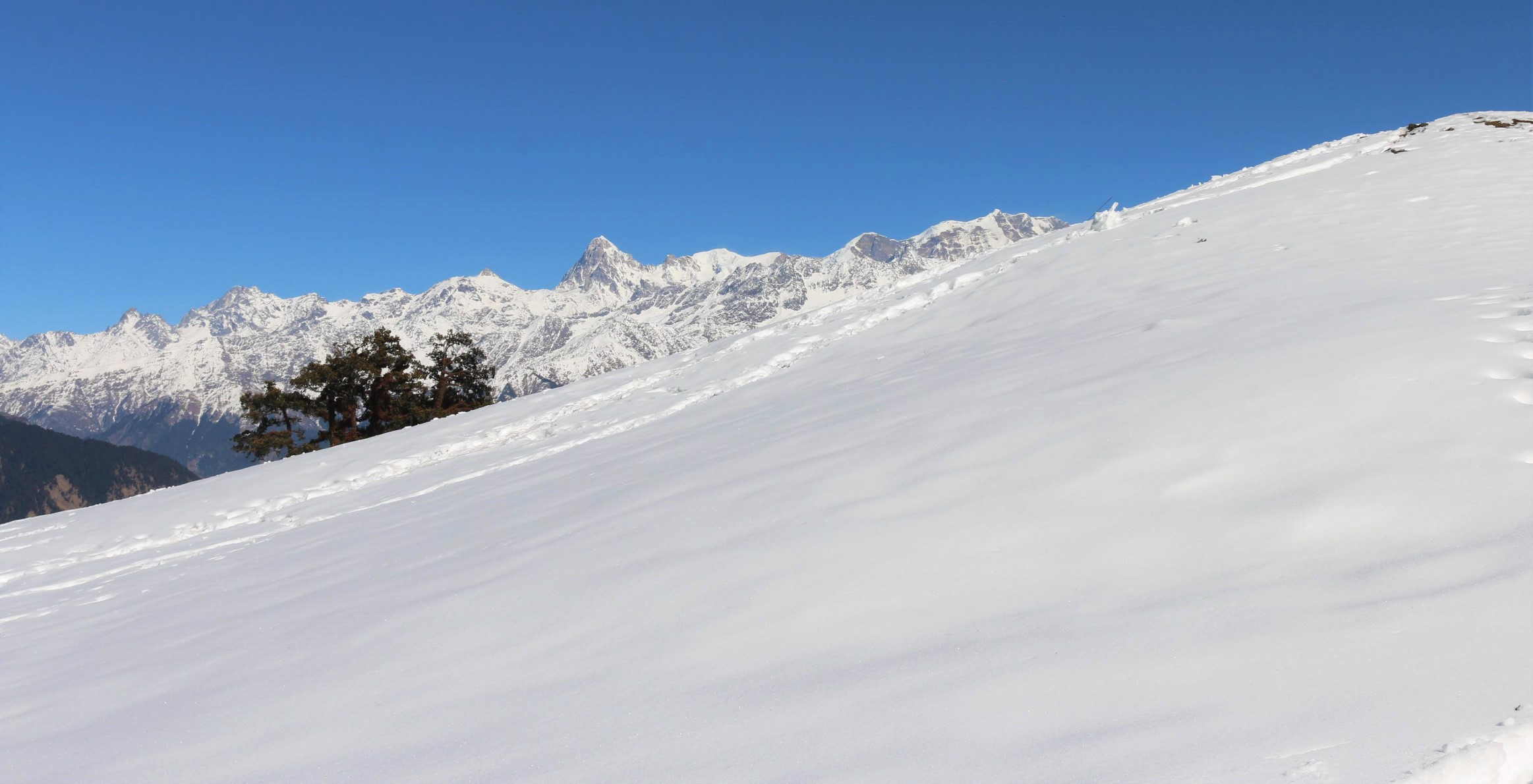
Fitness Target
For Easy – Moderate Treks – In order to be well-prepared for your upcoming trek, it is recommended that you focus on building your endurance by aiming to cover a distance of 4.5 kilometers in less than 45 minutes. This will help you to develop the necessary stamina and strength required to successfully complete your journey.
How to Achieve This Fitness Target?
To start preparing for your trek:
- Try jogging for at least five days every week.
- If you find 5 km too difficult at first, begin with 2 km and gradually increase over 2-3 weeks.
- Once you feel more comfortable running 5 km, focus on improving your speed gradually on a daily basis.
It is important to ensure that you can consistently complete 4.5 km in under 40 minutes for at least two weeks before your planned trek. Allow yourself 6-8 weeks to prepare physically for the journey.
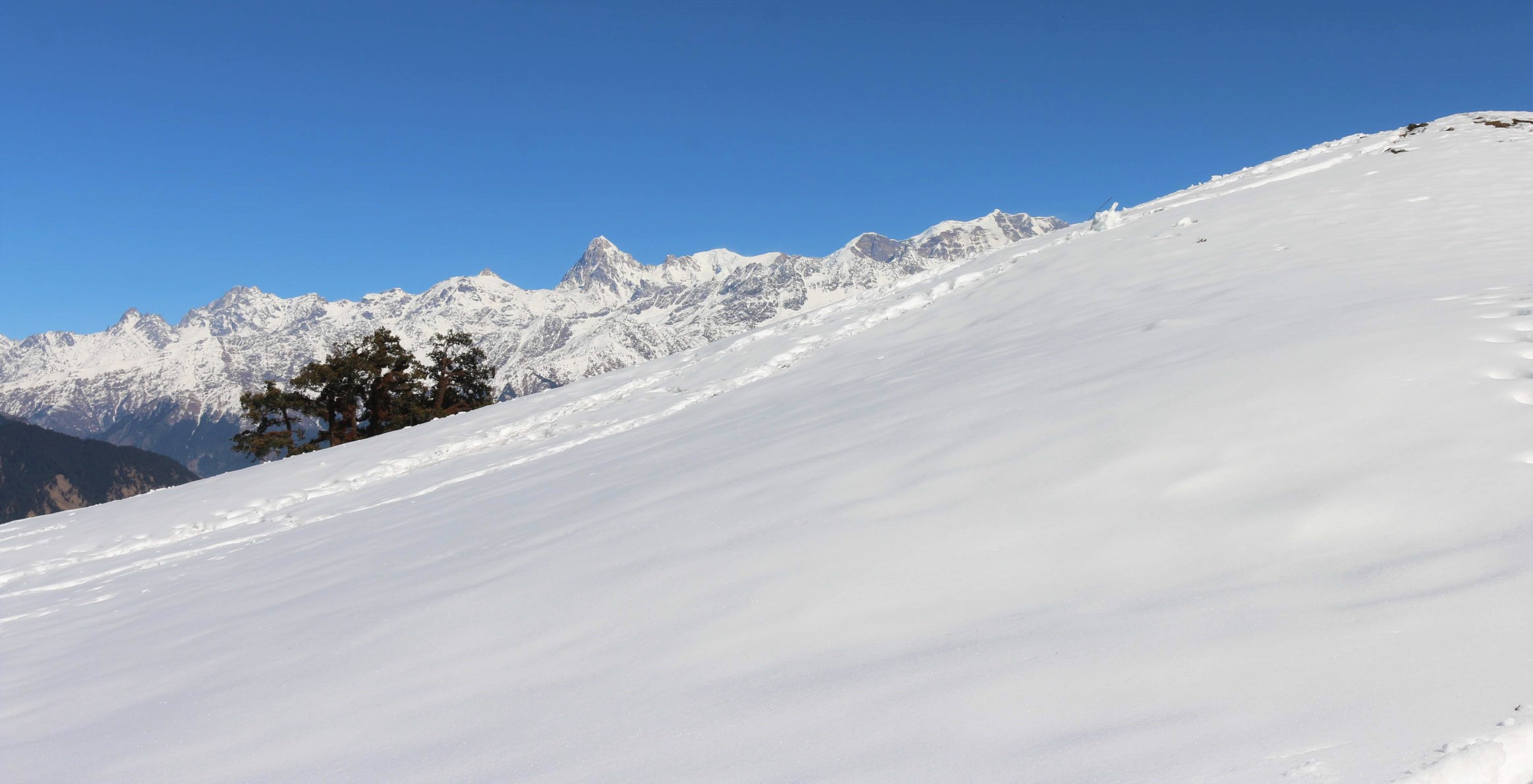
Strength Training exercises that benefit Trekking
Trekking is a demanding activity that requires good cardiovascular endurance, muscular strength, and overall fitness. To help you prepare for your trek, incorporating bodyweight exercises into your training routine can be an effective way to build strength, improve stability, and enhance endurance, all of which are crucial for a successful trek. In this regard, here’s a breakdown of body weight exercises categorized by the specific body parts they target and the benefits they offer during trekking.
1. Lower Body Exercises
Lower body exercises like squats and lunges are great for building lower body strength, essential for trekking.
a. Squats
Squats are an excellent exercise for building lower body strength, essential for trekking. They target the quadriceps, hamstrings, glutes, and calves. Solid quadriceps and glutes provide power for ascending and tackling uphill climbs, while vital hamstrings aid stability during descents. This is particularly helpful in navigating uneven terrain during trekking.
How to perform Squats Exercises:
- Stand with feet shoulder-width apart, toes pointing slightly outward.
- Lower your body by bending your knees and hips, keeping your back straight.
- Lower until your thighs are parallel to the ground or as low as comfortable.
- Push through your heels to return to the starting position.
b. Lunges
Lunges target the quadriceps, hamstrings, glutes, and calves. They improve lower body strength, balance, and stability, crucial for maintaining control on rocky trails and steep slopes. Additionally, they enhance flexibility, reducing the risk of injury while trekking.
How to Perform Lunge Exercises:
- Stand with feet hip-width apart, hands on hips or sides.
- Take a step forward with one foot, lowering your body until both knees are bent at 90-degree angles.
- Push through the heel of your front foot to return to the starting position.
- Repeat on the other side, alternating legs.
2. Upper Body Exercises
Upper body exercises such as push-ups and pull-ups effectively strengthen the upper body, especially the chest and shoulders, which are essential for carrying a backpack during treks.
a. Push-Ups
Targets: Chest, shoulders, triceps, and core.
Benefits for Trekking: Push-ups are an effective exercise to strengthen the upper body, especially the chest and shoulders, essential for carrying a backpack during treks. Improved upper body strength will also help maintain posture and stability while traversing challenging terrain.
How to Perform Push-Ups Exercises:
- Start in a plank position with hands shoulder-width apart and body in a straight line from head to heels.
- Lower your body by bending your elbows until your chest nearly touches the ground.
- Push through your palms to return to the starting position.
- Keep your core engaged throughout the movement.
b. Pull-Ups/Bodyweight Rows:
Targeting the back, biceps, and shoulders can significantly benefit trekking. You can strengthen these muscle groups by performing pull-ups or bodyweight rows and improve your posture and balance while carrying a backpack. Additionally, more muscular back muscles can help reduce the risk of back strain and fatigue during long treks, making your journey safer and more comfortable.
3. Core Exercises
Core exercises like planks and Russian twists can help strengthen the core muscles, which are crucial for maintaining stability and balance while trekking on uneven terrain.
a. Planks
Targets: Abdominals, obliques, and lower back.
Benefits for Trekking: Planks are an effective exercise that helps strengthen the core muscles. These muscles are crucial for maintaining stability and balance while trekking on uneven terrain. A strong core also helps improve posture, reducing the risk of back pain and fatigue during extended hikes.
How to Perform Planks Exercises:
- Start in a plank position with elbows directly under shoulders and body in a straight line from head to heels.
- Engage your core and hold the position, avoiding sagging or arching the back.
- Keep breathing steadily and hold for the desired duration.
b. Russian Twists
Targets: Obliques, abdominals, and lower back.
Benefits for Trekking: Russian twists engage the core muscles, particularly the obliques, improving rotational stability and balance. Enhanced core strength helps prevent injuries and improves overall performance during trekking.
How to Perform Russian Twist Exercises:
- Sit on the ground with knees bent and feet flat, leaning back slightly to engage the core.
- Clasp hands together and twist the torso to one side, bringing the hands towards the ground beside the hip.
- Return to the centre, then twist to the other side.
- Continue alternating sides for the desired number of repetitions.
4. Full Body/Cardiovascular Exercises
Full-body/cardiovascular exercises like burpees and mountain climbers are excellent for improving cardiovascular endurance, strength, and agility.
a.Burpees
Burpees are an excellent full-body exercise that targets your legs, chest, arms, and core. This exercise dramatically benefits trekking enthusiasts, improving cardiovascular endurance, strength, and agility. Regularly incorporating burpees into your workout routine can enhance your overall fitness level, which can help you endure long hikes and rugged terrains with ease.
How to Perform Burpees Exercises:
- Start in a standing position.
- Squat down and place hands on the ground.
- Jump feet back into a plank position.
- Perform a push-up.
- Jump feet back to the squat position.
- Explosively jump up into the air, reaching overhead.
- Land softly and repeat the sequence.
b. Mountain Climbers
Mountain climbers target the core, shoulders, chest, and legs. This dynamic, full-body exercise can significantly improve cardiovascular endurance and agility. It is an excellent functional workout for trekking preparation as it engages both the upper and lower body muscles while strengthening the core muscles.
How to Perform Mountain Climbers Exercises:
- Start in a plank position with hands shoulder-width apart and body in a straight line from head to heels.
- Drive one knee towards the chest, then quickly switch legs, alternating in a running motion.
- Keep the core engaged and the hips stable throughout the movement.
- Continue at a moderate to fast pace for the desired duration.
Incorporating bodyweight exercises into your training routine can help you build strength and endurance and prepare your body for the physical demands of trekking. Consistency and proper form are crucial to maximizing the benefits of these exercises and ensuring a safe and enjoyable trekking experience. Engaging your core muscles, including obliques, abdominals, and lower back, with Russian twists can improve your rotational stability and balance, preventing injuries and enhancing overall performance during trekking.
When incorporating strength training exercises into your workout routine, it’s essential to maintain proper form and technique to avoid injury. Start with lighter weights and gradually increase the intensity as you progress, focusing on compound exercises targeting multiple muscle groups simultaneously. Some examples of practical strength training exercises for trekking include squats, lunges, deadlifts, and pull-ups.
Remember to give your muscles time to recover between workouts, and remember to stretch before and after your workouts to prevent injury and improve flexibility. Combining strength training with jogging and proper stretching allows you to take your fitness to the next level and confidently tackle even the most challenging treks.
Food Provided by Us During Dayara Bugyal Trek
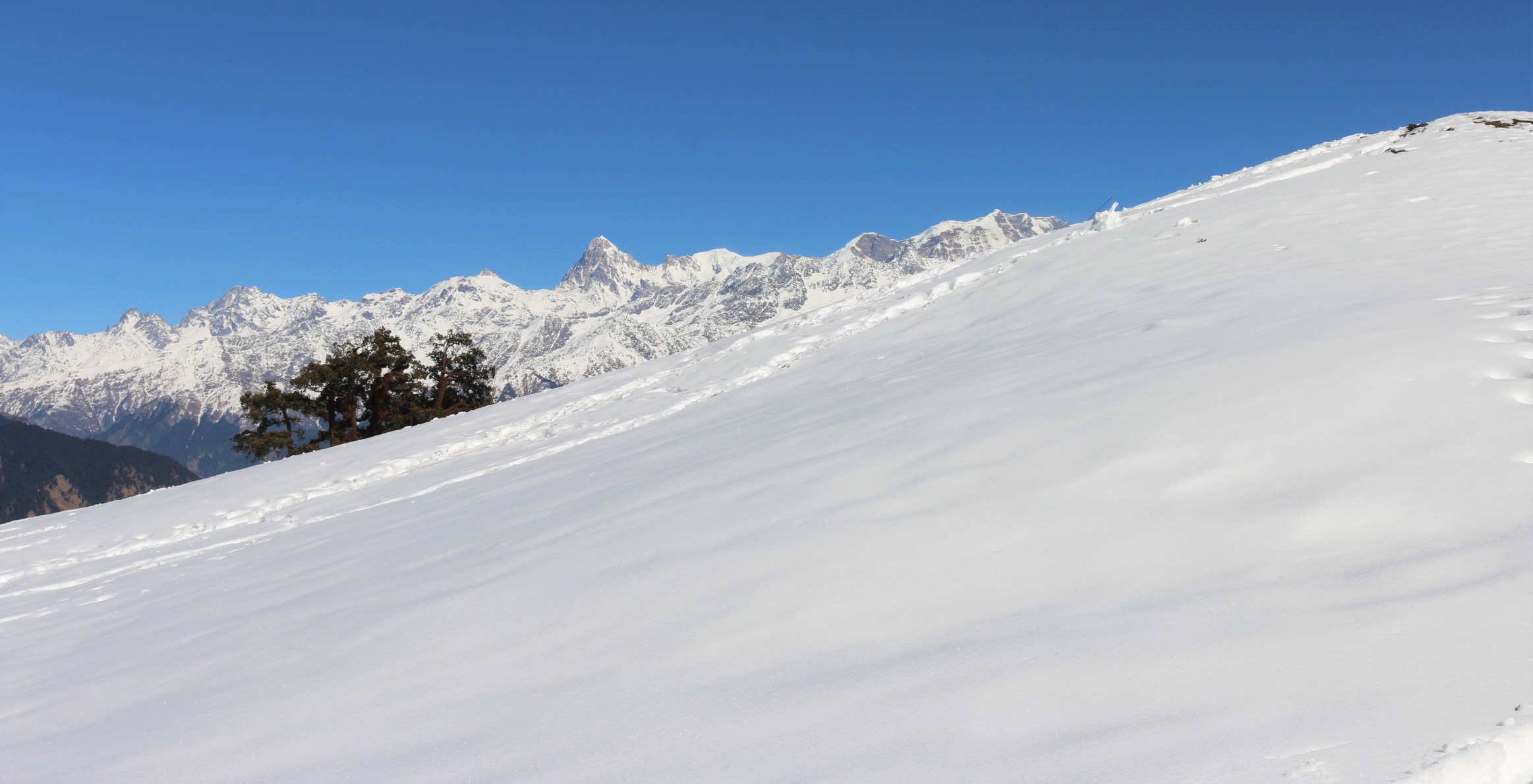
We provide only Indian vegetarian food, and your meal will mainly consist of Indian bread, vegetables, lentils, rice, and a delicious dessert. During your trek, we will serve three meals a day, including breakfast, lunch, and dinner. You will also be served tea, snacks, and lip-smacking soup in the evening before dinner. If it is a long day of trekking, you will be given a packed snack.
After extensive research on the trekkers’ nutritional requirements, we prepare the menu. Before putting all the meals together, we also consider the altitude and the weather.
The meal we serve during the trek is perfectly balanced with calories, carbohydrates, vitamins, protein, fibre, and minerals. You need to know that all our cooks have great expertise in cooking and have undergone thorough training. So, get ready to enjoy delectable and lip-smacking dishes during your trek. You will be served with lemon tea in the tent to start your day with a refreshed feeling. Before leaving the campsite for trekking, you will be given a hot finger-licking breakfast like upma, Aallu Prantha, Besan Chilla, Poha, Daliya, Corn flakes, and Maggie, along with tea or coffee.
If your trek is longer, we also offer some fresh local fruits such as apples and healthy drinks like Frootie or Maaza. In the afternoon, you will be served a simple & healthy lunch, while at around 04:00 pm, you will be given tea and a light evening breakfast. After you reach your campsite at night, you will be served a hot and delightful dinner.
After reading this, you must have understood the food we provided on the trek; you don’t need to worry about food. Many trekkers repeatedly trek with us because of the food we provide. Thus, we will give you unforgettable experiences.
Safety During Trek
Trekking with us for the Dayara Bugyal Trek is entirely safe because we have a team of trek leaders qualified in Wilderness first-aid and complete information about the high-altitude glitches. During the trek, we carry a full first-aid kit that contains all the essential medicines. Before trekking with us, you must ensure that you are medically fit for the trek; for us, your medical fitness is more important than anything else.
Right from our establishment, we at The Dreamtrips have been continuously introducing new safety practices into Indian trekking to ensure the safety of voyagers.The Dreamtrips introduced microspikes and made emergency bottled oxygen mandatory for all treks. Our trek leaders take your daily Pulse oximeter reading. We at The Dreamtrips introduced the radio walkie-talkie as a safety communication device.
How can we ensure that your trek is safe with us?
We have noticed that most trek-organizing organizations do not follow these systems, but with time, they are following us; several competing companies are adopting these practices and organizing great, safe treks.
We ensure complete technical safety in the mountain. Our company has a vast team of more than 100 guides and trek leaders who serve on Himalayan treks. One of the best things about our team is that all the members are trained professionally by the Nehru Institute of Mountaineering, Indian Mountaineering Foundation Delhi, and Hanifle Center Outdoor Education Mussoorie.
Explore our New Safety Protocols
To ensure a perfect Trek, we have introduced some new safety checks to ensure excellent safety for our trekkers.
Our On-trek safety checks include:
- Daily oxygen saturation, along with pulse readings
- Stretchers team appointed on every trek
- Radios
- Trained mountain staff and complete safety
- Additional oxygen cylinders
- Special medical kit for high-altitude treks
- Microspikes on all types of snow treks
- Experienced Trek leaders, as well as safety
- Technical team on all snowy slopes
For Us, Your Safety Is the Top Priority
At The Dreamtrips, you will find a team with local knowledge and fluency in English and Hindi. This helps ensure that you have a fantastic trek. Not only this, but we also pay attention to your health and safety because this is something we cannot ignore. All the team leaders involved in trekking have already undergone several professional courses in first aid, portable altitude chamber training, CPR, environmental awareness training, and advanced wilderness emergency medicine.
We also carry a complete first aid medical kit on every trek and trip we organize. Apart from the medical kit, we take a portable altitude chamber (if needed) and medical oxygen for all high-altitude treks. Our company has significant expertise in organizing all sorts of group adventure holidays for family groups, school and college groups, and friend groups. We have many travel options that suit different fitness levels and travelling styles.
Regardless of the group size, we value each and every member of our trekking groups. Our commitment to personal attention ensures that your needs and safety are always our top priority.
Must Read These Information
-
Best time to do Dayara Bugyal Trek
The Dayara Bugyal trek is available throughout the year, except during the rainy season. This implies that the trek is accessible and enjoyable for approximately 8 months annually. Excluding the monsoons, there are 4 unique seasons to appreciate Dayara Bugyal – Winter, Spring, Summer, and Autumn. Each season has its charm and offers a different experience.
-
Why You Should Do Dayara Bugyal Trek?
As I ventured into the meadows, I was struck by their immense size. The landscape seemed to stretch on forever, with no visible end in sight. My curiosity piqued, I decided to explore further. I climbed two small hills, but the view from the top was limited to more of the same: endless green meadows. Undeterred, I pressed on towards Bakhariya top, the highest point in the area. The journey was long and arduous, but eventually, I reached a ridge that led to a hilltop. From this vantage point, I gazed out at a breathtaking sight: a deep valley, nestled between rolling hills and towering mountain ranges. In the distance, the majestic Mt Bandarpoonch loomed large, while below me lay an endless expanse of lush, green meadows.
Frequently Asked Questions
-
What is the duration Of the Dayara Bugyal Trek?
Its a 4 days and 3 nights trek
Recognition & Association




